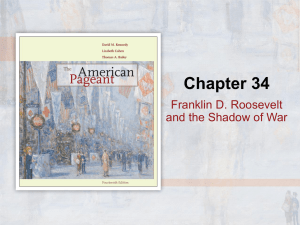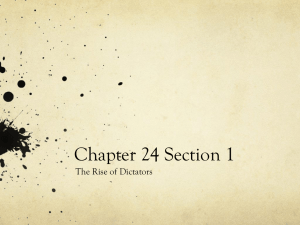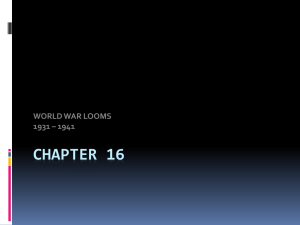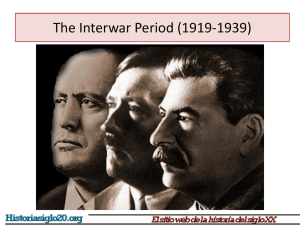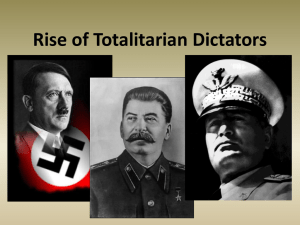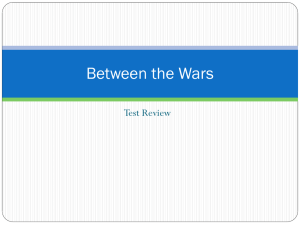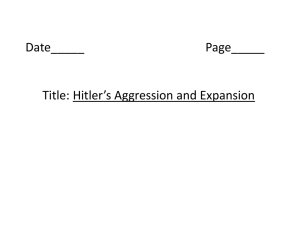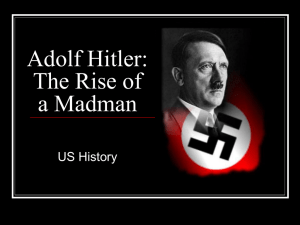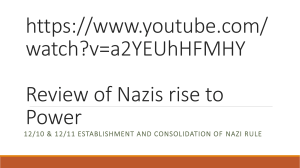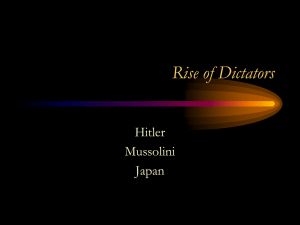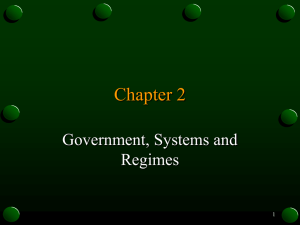WS06 – Ch 15.1-3 (all) – The West between the
advertisement
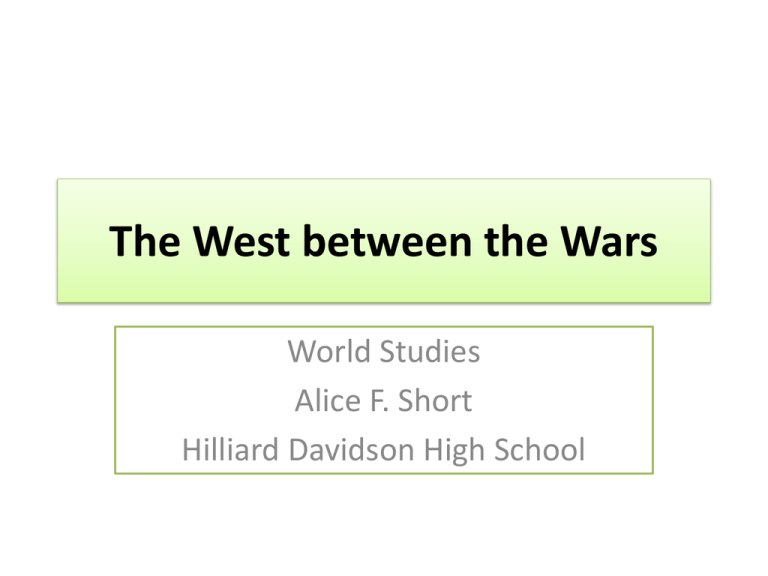
The West between the Wars World Studies Alice F. Short Hilliard Davidson High School Chapter 15: The West between the Wars • Lesson 1 – Instability After World War I • Lesson 2 – The Rise of Dictatorial Regimes • Lesson 3 – Hitler and Nazi Germany Chapter 15 Overview: The West between the Wars • peace and prosperity were short-lived after World War I as the global depression weakened Western democracies • WWI influenced the arts and sciences (increased uncertainty, darker perspective) • By 1939, many European countries had adopted dictatorial regimes that aimed to control every aspect of their citizens’ lives for state goals • Hitler’s totalitarian state was widely accepted, but German Jews and minorities were persecuted – Hitler promoted Nazism in many ways Instability After World War I Chapter 15, Lesson 1 • Uneasy Peace, Uncertain Security – League of Nations • U.S. didn’t join • Ineffective – Treaty of Versailles • punished / humiliated Germany • war reparation (to France and Great Britain) – financial crisis France occupied Ruhr Valley in Germany – Inflation in Germany – Treaty of Locarno • guaranteed Germany’s new western borders with France and Belgium – Kellogg-Briand Pact • 65 nations pledged to “renounce [war] as an instrument of national policy” (no consequences planned) The Treaty of Versailles Instability After WWI Chapter 15, Lesson 1 • Great Depression – depression – a person of low economic activity and rising unemployment – Causes of Depression: FARMERS WENT INTO DEBT, RISKY INVESTMENTS FAILED, BANKS RAN OUT OF MONEY – banks = largely responsible • Stock Market Crash: market speculations with loaned money • international financial crisis • loans became difficult to get major problem Instability After World War I Chapter 15, Lesson 1 • Responses to the Depression – 1932 – worst year of depression • 25% of Britain unemployed • 30% of Germans unemployed – democracy under attack – women gained the right to vote in some places Instability After World War I Chapter 15, Lesson 1 • Germany – Weimar Republic (unpopular) – runaway inflation (1922-23) • fixed income lost everything – paved the way for fear and the rise of extremist parties • DISCUSSION: Why? Instability After World War I Chapter 15, Lesson 1 • France – difficulties after WWI • MIGINOT LINE HURT ECONOMY, • FARMLAND WAS IN RUINS, • YOUNG MEN LOST LIVES HURTING POPULATION – 1932-33 – 19 month period with 6 different cabinets (political chaos) – Popular Front Government • 1936 – coalition of leftist parties – communists, socialists and radicals • French New Deal – collective bargaining – minimum wage – 40-hour work week Instability After World War I Chapter 15, Lesson 1 • Great Britain – 1925-1929 – limited prosperity – Labour Party • failed to solve economic problems – Conservatives • pulled out of worst of depression • balance budgets • protective tariffs • John Maynard Keynes – unemployment came from a decline in demand, not from overproduction – increase demand by creating jobs – deficit spending – when a government pays out more money than it takes in through taxation and other revenues, thus going into debt Instability After World War I Chapter 15, Lesson 1 • The United States – Industrial production fell 50% (1929-1933) – 1932 – FDR won presidential election (crushed it!) – New Deal • Works Progress Administration (WPA), 1935 – employed 3 million – built bridges, roads, post offices and air ports • Welfare • Social Security Act, 1935 – old age pensions – unemployment insurance – unemployment still grew • WWII and weapons industries fixed unemployment • WWII ended Great Depression Instability After World War I Chapter 15, Lesson 1 • Arts – fascination with absurd and unconscious • “The world does not make sense, so why should art?” – Dadaism – artists obsessed with the idea that life has no purpose – surrealism – an artistic movement that seeks to depict the world of the unconscious • Salvador Dali – The Persistence of Memory • Sciences – 1920s-30s – “heroic age of physics” • Werner Heisenberg’s uncertainty principle – (1927) – the idea that the behavior of subatomic particles is uncertain, suggesting that all of the physical laws governing the universe are based in uncertainty The Rise of Dictatorial Regimes Chapter 15, Lesson 2 • The Rise of Dictators – 1939 – only France and GB remain democracies – totalitarian state – a government that aims to control the political, economic, social, intellectual, and cultural lives of its citizens • minds and hearts – PROPAGANDA and mass communication • single leader, single party • individual will subjective to collective will, as determined by the leader • masses actively involved in achieving state goals The Rise of Dictatorial Regimes Chapter 15, Lesson 2 • Fascism in Italy – Benito Mussolini, Il Duce • Fascio di Combattimento (League of Combat) • fascism – a political philosophy that glorifies the state above the individual by emphasizing the need for a strong central government led by a dictatorial rule – nationalistic appeals • Fascists used a private army called the BLACK Shirts. – middle class – fear of communism, socialism, disorder – police – unrestricted authority to arrest and jail anyone for either political or nonpolitical crimes • secret police (OVRA) – watched indiv. political activities – control over media (newspapers, radio and film) • “Mussolini is always right.” • 2/3 in fascist youth groups fit, disciplined and war-loving – traditional social values family = pillar of state – Catholicism survived (Vatican City, national religion, support fascists) – Rome-Berlin Axis: Mussolini in Italy and Hitler in Germany The Rise of Dictatorial Regimes Chapter 15, Lesson 2 • From Russia to the USSR – Lenin • war communism • command economy - GOVERNMENT MAKES ALL ECONOMIC DECISIONS • 1920-22 drought – 5 million starved • 1913-1921 – 80% decrease in industrial production • “Down with Lenin and horse flesh. Bring back the Czar and pork.” – Leon Trotsky – Lenin’s New Economic Policy (NEP) • small-level capitalism • heavy industry, banking, mines = government controlled • saved Soviet Union from complete economic disaster The Rise of Dictatorial Regimes Chapter 15, Lesson 2 • From Russia to the USSR (cont.) – The Soviet Union • 1922 – Lenin and Communists Union of Soviet Socialist Republics (USSR) • production at 75% of prewar levels • 1924 – Lenin dies power struggle – 7 member Politburo – the Communist Party’s main policy-making body – Leon Trotsky – expand industrialization (at expense of peasants) and expand communist abroad – opposition: socialism, continue NEP The Rise of Dictatorial Regimes Chapter 15, Lesson 2 • From Russia to the USSR (cont.) – Joseph Stalin and His Five-Year Plans – intense personal rivalry between Stalin and Trotsky Stalin wins • 1927 – Trotsky flees to Mexico, 1940 assassinated – 1928 – ended NEP, launch First Five-Year Plan • economic goal: agricultural industrial • production of military and capital goods – goods devoted to the production of other goods such as heavy machines – 4x heavy machinery production; 2x oil production The Rise of Dictatorial Regimes Chapter 15, Lesson 2 • From Russia to the USSR (cont.) – Costs of Stalin’s Programs • • • • real wages decline by 43% (1928-1940) housing investments declined terrible living conditions for workers collectivization – a system in which private farms are eliminated and peasants work land owned by the government (private farms eliminated) – resistance: hoarding crops and killing livestock – led to widespread famine (1932-33, 10 million died) • forced labor camps in Siberia • Great Purge – 8 million arrested and sent to labor camps – Executions - ELIMINATE DISLOYAL PARTY MEMBERS • parent = small collective – teach hard work, duty, discipline The Rise of Dictatorial Regimes Chapter 15, Lesson 2 • Authoritarian States in the West – – – – – – Eastern Europe not totalitarian used police powers preserve existing social order historically: rural, agrarian, no democratic tradition, Czechoslovakia – maintained democracy • large middle class • liberal tradition • strong industrial base The Rise of Dictatorial Regimes Chapter 15, Lesson 2 • Authoritarian States in the West – Spain • General Francisco Franco, revolted 1936 • Spanish Civil War – Hitler and Mussolini aided Franco – arms, money, soldiers – 1939-1975 – dictatorship established by Franco » favored traditional groups » did not control all aspects of peoples’ lives » harsh – special police forces, exiles, imprisonment Hitler and Nazi Germany Chapter 15, Lesson 3 • Hitler and Nazism – Nazi (National Socialist German Workers’ Party, NSDAP) • 2 years – 55,000 members • 15,000 in party militia (SA/Storm Troops/Brownshirts) – Beer Hall Putsch (1932) • Hitler sentenced to prison wrote Mein Kampf – German nationalism, strong anti-Semitism, anticommunism LINKD by a Social Darwinism theory of struggle – Lebenstraum “living space” through expansion Hitler and Nazi Germany Chapter 15, Lesson 3 • Hitler and Nazism – Rise of Nazism • Nazis obtain power legally • 3 years 800,000 member, largest rep. in Reichstag • terrible conditions helped Nazi rise to power • appealed to nationalism and militarism – The Nazis Take Control • 1933 – Pres. Hindenberg allowed Hitler became Chancellor and to create a new government – Enabling Act (1933) – 2/3 vote gave Hitler the ability to ignore the constitution for 4 years (essentially voted-in dictatorship) • removed all Jews from government • built concentration camps – a camp where prisoners, or members of minority groups are confined, typically under harsh conditions • banned all other political parties • 1934 – Hindenberg dies presidency abolished Hitler is the Fuhrer! Hitler and Nazi Germany Chapter 15, Lesson 3 • The Nazi State, 1933-1939 – Aryan – a term used to identify people speaking Indo-European languages; Nazis misused the term, treating it as a racial designation and identifying the Aryans with the ancient Greeks and Romans and twentieth-century Germans and Scandinavians – mass demonstrations and spectacles • Nuremberg party rallies every September Nuremberg Party Rallies Hitler and Nazi Germany Chapter 15, Lesson 3 • The Nazi State, 1933-1939 – The State and Terror • schutzstaffeln “Guard Squadrons” (SS) – Heinrich Himmler – control of secret police and regular police – terror: instruments of repression and murder secret police, criminal police, concentration camps… execution squads and death camps – ideology: further the “Aryan master race” – Economics • public works and grants put people back to work • rearmament largely fixed unemployment The SS • schutzstaffeln “Guard Squadrons” Hitler and Nazi Germany Chapter 15, Lesson 3 • The Nazi State, 19331939 – Women and Nazism • bearers of Aryan children (honor) • encouraged to leave “difficult” or “serious” professions • encouraged to pursue social work and nursing Hitler and Nazi Germany Chapter 15, Lesson 3 • The Nazi State, 1933-1939 – Anti-Semitic Policies • Nuremburg Laws, 1935 – Jew = anyone with one Jewish grandparent – stripped Jews of citizenship – banned marriage between Jews and German citizens – later forced to wear Stars of David • Kristallnacht – “night of shattered glass” – synagogues and Jewish-owned business destroyed – 30,000 Jewish males arrested sent to concentration camps – Jews barred from public transportation, public buildings (includes schools and hospitals) Kristallnacht Hitler and Nazi Germany Chapter 15, Lesson 3 • The Nazi State, 1933-1939 – Culture and Leisure • Joseph Goebbels, German propaganda minister – Kraft durch Freude “Strength through Joy” – radio, movies, concerts, operas, films, guided tours, sporting events • Marconi’s invention of radios – encouraged (inexpensive, buy on payment plan) • movies (40% of adults seeing 1 movie per week) – feature films and documentaries supporting Nazi message • 1936 Berlin Olympics Dictator Breakdown: Fascists vs. Communists Fascist Dictators: Benito Mussolini Francisco Franco Hitler Communist Dictators: Lenin Stalin

